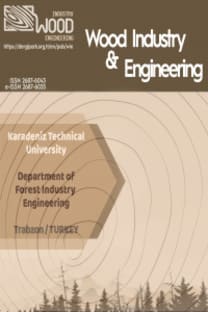POTENTIAL USAGE AREAS OF IIOT IN FOREST PRODUCTS INDUSTRY
The increasing usage of wood materials in the industry necessitates correct, effective and sustainable use of existing raw material resources. In this context, the concept of Industry 4.0, which includes smart production systems, smart objects, and smart management models, stands out. Industry 4.0 is defined by the concept where human, machinery, robotic control equipment, products and all related objects can communicate with each other; thus lines are arranged, and eventually they work as a networked system. IoT (Internet of Things) is defined as the communication of all elements/objects within the industry 4.0 system. In the light of current developments, the use of technology in the routine life activities of people is expanding. The most striking example of this is the progress in the telecommunication sector like smartphones. The aim here is not only to ensure verbal communication between people, but also the communication between objects, and objects with people. This creates the system referred as IoT. IIoT (Industrial Internet of Things), also called industrial internet, is the use of IoT in industry/manufacturing. This means that the whole supply chain works in interrelation. In this paper, the definition of IIoT concept and its potential in the forest products industry are examined.
Keywords:
IIoT, Internet of Things, Industry 4.0,
___
- Canavan, L. (2020, January 13). What is IIoT? The Industrial Internet of Things Primer. Retrieved October 06, 2020, from https://www.rti.com/blog/the-iiot-primer
- Doyle, M. (2020, February). [Digital image]. Retrieved October 8, 2020, from https://blog.nextbigthing.ag/industrial-iot-12-use-cases-accelerating-success
- Gubbia, J., Buyyab, R., Marusic, S., Palaniswami, M., Internet of Things (IoT): A vision, architectural elements, and future directions, Future Generation Computer Systems, 29, September 2013
- Jeffrey Lee (2017), What Separates IIoT From IoT: Uses and Priorities, October 27, 2017, IoT Zone, [online] https://dzone.com/articles/what-separates-iiot-from-iot?fromrel=true
- Khan, W., Rehman, M., Zangoti, H., Afzal, M., Armi, N., & Salah, K. (2020). Industrial internet of things: Recent advances, enabling technologies and open challenges. Computers & Electrical Engineering, 81, 106522. doi:10.1016/j.compeleceng.2019.106522
- Kumar, A., Iyer, E. (2019). An industrial iot in engineering and manufacturing industries–benefits and challenges. Retrieved October 06, 2020, from https://www.researchgate.net/profile/Senthil_Kumar_Arumugam2/publication/336216692_an_industrial_iot_in_engineering_and_manufacturing_industries_benefits_and_challenges/links/5d94a462458515202b7c0557/an-industrial-iot-in-engineering-and-manufacturing-industries-benefits-and-challenges.pdf
- Ocak, O., Tuncel, S., Candan, Z. 2018. Industry 4.0 and ERP integration in wood industry. 5th International Furniture Congress, November 1-4, 2018, Eskisehir, Turkey.
- Silicon Labs. (2018, June 29). Smart Meter Devices. Retrieved October 8, 2020, from https://www.silabs.com/solutions/smart-meters
- Top 5 Industrial IoT Use Cases. (2020, January 04). Retrieved October 9, 2020, from https://www.hiotron.com/top-5-industrial-iot-use-cases/
- What is Industrial IoT (IIoT) and how is it different from IoT? [Digital image]. (2019, March 24). Retrieved October 8, 2020, from https://blog.3g4g.co.uk/2019/03/what-is-industrial-iot-iiot-and-how-is.html
- Tuncel, S., Candan, Z., Satir, A. 2017. Future vision in furniture industry: Industry 4.0. Journal of Advanced Technology Sciences, 6(3): 152-159.
- Tuncel, S. Candan, Z., Satir, A. Laci, M. 2018a. Costing practices with industry 4.0 approach. The International Forest Products Congress, September 26-29, 2018, Trabzon, Turkey.
- Tuncel, S., Candan, Z., Gezer, M., Seker, M. 2018b. An innovative method for determining consumer behaviors in the furniture industry: face recognition system. 5th International Furniture Congress, November 1-4, 2018, Eskisehir, Turkey.
- Tuncel, S. Candan, Z., Satir, A. 2019. Innovative approaches in wood industry. Wood Industry and Engineering 1(2):81-87.
- ISSN: 2687-6043
- Başlangıç: 2017
- Yayıncı: Karadeniz Teknik Üniversitesi
